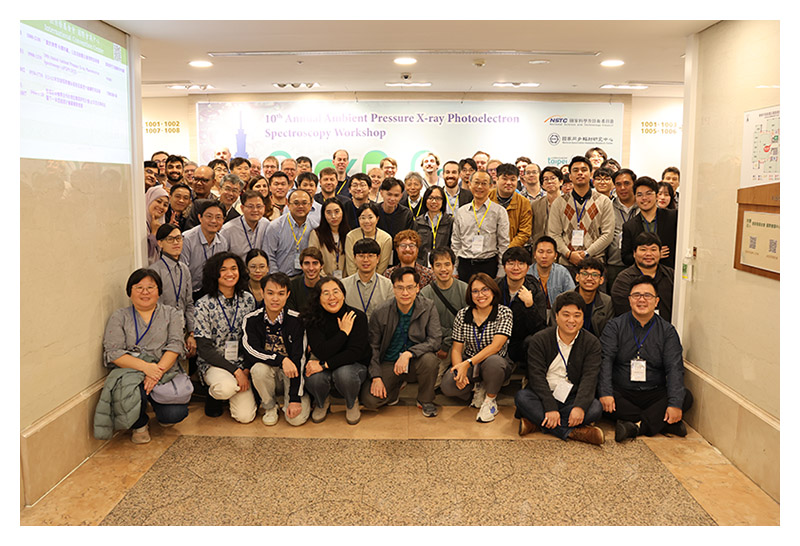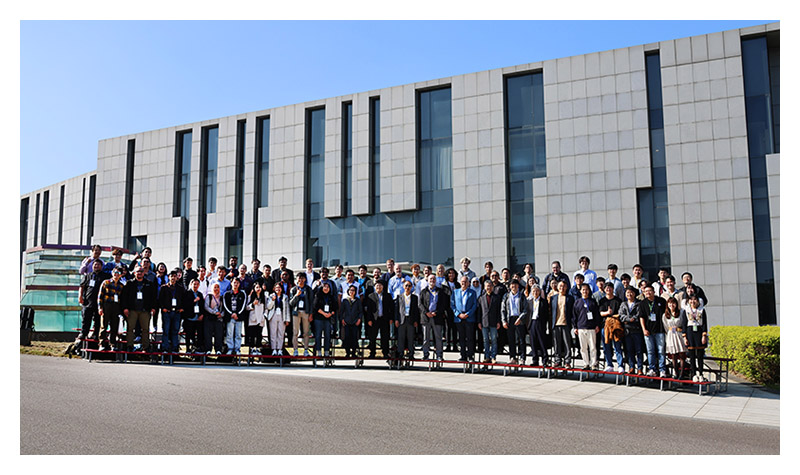Volume 29, No.1 Pages 37 - 39
3. 研究会等報告/WORKSHOP AND COMMITTEE REPORT
Conference report: 10th Annual Ambient Pressure X-ray Photoelectron Spectroscopy Workshop
(公財)高輝度光科学研究センター 放射光利用研究基盤センター 産業利用・産学連携推進室 Industrial Application and Partnership Division, Center for Synchrotron Radiation Research, JASRI
1. Introduction
As COVID-19 is gradually ending, many academic societies are reverting back to onsite workshops from virtual ones. The 10th Annual Ambient Pressure X-ray Photoelectron Spectroscopy Workshop was held onsite at the Chang Yung-FA Foundation (CYFF) International Convention Center in Taipei, Taiwan, from December 5 to 8, 2023. This workshop is held annually under the single topic of Ambient Pressure X-ray Photoelectron Spectroscopy (AP-XPS). It is a significant event as it garners much interest in AP-XPS. Furthermore, with the construction of a new AP-XPS beamline, the AP-XPS workshop is expected to grow even more. Over 100 researchers, including approximately 30 oral and 30 poster presenters, attended this workshop and shared the latest research trends and beamline upgrade information. Unfortunately, researchers working in China could not participate in this workshop as an onsite.

Figure 1 Group photo of 10th Annual Ambient Pressure X-ray Photoelectron Spectroscopy workshop at the CYFF international convention center.
2. Workshop
The workshop started with a speech by Dr. Chai-Hung Hsu at the National Synchrotron Radiation Research Center (NSRRC) in Taiwan. This workshop's plenary talk was given by Prof. Anders Nilsson from Stockholm University, Sweden, with the title "Ambient XPS Studies of CO/CO2 and N2 Catalytic Reduction Reactions". His research focused on surface science and shared insights on the Haber-Bosch process, which interests people in reducing CO2 gas, the primary cause of greenhouse gases, and matching components to manufacture new energy sources. Despite the high temperature and pressure required for the Haber-Bosch process, he experimentally showed that it is possible even at 100 mbar ~ 1 bar on a well-arranged Fe single crystal surface. He conducted the AP-HAXPES (Hard X-ray Photoelectron Spectroscopy) experiments at the P22 beamline of PERTA-III, Germany, to understand the surface reaction process and mechanism. Although most surface reactions in a single crystal were observed using soft X-ray techniques, it was interesting to use HAXPES to observe reactions under high pressure. He performed AP-HAXPES experiments at the total reflection region using grazing incident geometry to observe the surface-sensitive area of a single crystal.
Prof. J. Knudsen of NanoLund/MAXIV laboratory, Sweden, presented research results on "Probing minority sites and their activity using chemical perturbations and Fast Fourier Transformed Ambient Pressure X-ray Photoelectron Spectroscopy". His research aimed to determine the reaction results of gas reactions that occur in a repeated gas environment as a function of time by using FFT of C 1s and O 1s spectra while changing the CO: O2 gas ratio in a Pd (100) single crystal. The study analyzed the periodic weak signals of the surface CO gas phase and CO2 gas phase on the Pd (100) surface using FFT to determine the time at which the reaction occurred. This technique could be useful in observing the kinetics of gas reactions.
Dr. Slavomir Nemsak from the Advanced Light Source in the United States presented research results on "Correlating Chemical and Morphological Transformations through Multi-Modal X-ray Characterization". This method was a study on a method that can be measured simultaneously by introducing grazing incident small angle X-ray scattering (GI-SAXs) to the existing AP-XPS measurement method. It was a useful method to observe changes in both the electronic and crystal structure that can occur in the operation environment. In particular, because the BL46XU beamline uses the characteristic of hard X-ray, we could be applied to multi-modal X-ray techniques of the AP-HAXPES and AP- I powder X-ray diffraction (XRD).
One of the interesting highlights of the workshop was the presentation given by SPECS and Scienta Omicron, who manufacture AP-XPS equipment. They introduced new AP-XPS equipment that can operate even at high pressure and measure liquid conditions. One of the impressive features of the system was the ability to switch from a soft X-ray source (Al Kα) to a hard X-ray source (Cr Kα) with just a single button. They also showcased operation and analysis software that is easy for users to operate.
During the final day of the workshop, we had the opportunity to visit NSRRC. As part of the tour, we visited Taiwan Light Source (TLS) and Taiwan Photon Source (TPS) and attended a closing presentation by Dr. Yasumasa Takagi from JASRI. Dr. Y. Takagi presented research results on "Development of the ambient pressure hard X-ray photoelectron spectroscopy in BL46XU at SPring-8". During the presentation, he announced the improvement of energy resolution using a double channel-cut monochromator (DCCM). He shared detailed information on BL46XU beamlines, such as creating focused X-ray beams through the use of Wolter mirrors. He also explained the difference in photoelectron intensity loss between the 30 μm diameter and rectangular 20 × 80 μm2 aperture. Furthermore, he presented full atmospheric HAXPES results, measured with the chamber open, which demonstrated that XPS can be measured in air, contrary to what is stated in the textbook that it can only be measured in ultra-high vacuum. found this result to be surprising and interesting.
After Dr. Y. Takagi's presentation, the 11th Annual AP-XPS Workshop location was announced in an invitation video by Prof. Susumu Yamamoto from Tohoku University, Japan. It will be held at the newly built NanoTerasu in Sendai, Japan, from December 3 to 6, 2024. Since it is being held in Japan, I hope it will be a successful workshop, and I hope to participate in the next workshop as well.

Figure 2 Group photo of 10th Annual Ambient Pressure X-ray Photoelectron Spectroscopy workshop in front of TPS at NSRRC.
3. NSRRC tour and sightseeing
After that, there was a visit to the TLS and TPS facilities. Those are located with two light sources side by side. The fact that Taiwan has two synchrotron radiation research facilities shows that Taiwan scientists are serious about synchrotron radiation research fields, considering that South Korea currently only has one synchrotron radiation facility in Pohang. We were able to get a glimpse of Taiwan's developing synchrotron X-ray technology through a tour of the powder XRD, X-ray absorption fine structure, soft X-ray spectroscopy, and AP-XPS beamlines.
After finishing the 4-day workshop schedule, I headed to a famous night market called Shilin in Taipei. This night market was crowded with tourists and young people. I had stinky tofu and drank watermelon juice, brown sugar milk tea, and so on. It was an excellent opportunity to try out the local food of Taipei at a reasonable price. Furthermore, it was not difficult to enjoy Taipei as English was widely used, and the locals were very helpful towards tourists. Although I came to Taipei for a workshop, the city was impressive not only for science but also for its local cuisine, tourist attractions, and friendly people.
(公財)高輝度光科学研究センター
放射光利用研究基盤センター 産業利用・産学連携推進室
〒679-5198 兵庫県佐用郡佐用町光都1-1-1
TEL : 0791-58-0802
e-mail : seo.okkyun@spring8.or.jp








